Independent Building Surveyors
We are experienced independent building Surveyors who are knowledgeable in carrying out structural surveys on all types, styles and eras of buildings and we carry them out in all kinds of weather. We are always interested at how different weather conditions can affect the performance of a building.
Please call us on free phone 0800 298 5424 for a friendly chat about any property issues.
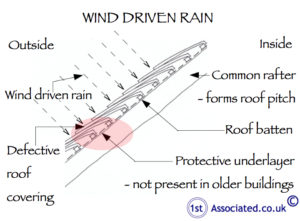
Shows how wind driven rain can
affect the roof of a property
Wind chill can make it feel much colder
In winter we experience cold days but the coldest days tend to be when there is a wind chill factor as well. The term wind chill is said to have originated from Paul Siple an Antarctic explorer in 1939. He carried out experiments to understand how quickly water froze dependent on a number of factors such as wind speed, the outside temperature and of course the temperature of the water. This was called the Siple – Passel test. This is all related to how the temperature feels to human beings rather than how cold the temperature actually is.
Wind chill affects buildings as well as people
Interestingly although we have read articles that say that wind chill is very much a human factor we feel it affects human beings within buildings as well. We do not have any scientific backing to this but we have carried out surveys on properties where there has been a lot of discomfort and also dampness, condensation, mould and black mould caused by, we feel, the wind chill factor or the accelerated wind around a building.

High levels of glazing combined
with accelerated wind through
the narrow gap between the
roads and the buildings can
cause wind chill
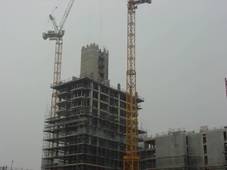
Flats with a concrete and metal
frame both of which suffer from
cold bridging
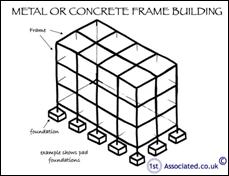
Metal or concrete frame
Cold bridging defined
Cold bridging is caused by a colder element in the structure allowing coldness to pass through the structure much quicker when warm moist air is present in the property.
We usually feel how windy it is but we can sometimes see and hear it as well
Standing inside a building and looking out often the only indication that it is very windy outside is the noise and moving trees or if you live near water you can see white caps on the waves on the water. The Beaufort wind scale is one way of measuring wind speed. This is very different to wind chill that relates more to the heat loss from humans and other living species.
The BBC produced an excellent article that started by saying the temperature in London is zero degrees but the temperature will feel like minus six degrees. This all relates to the wind chill factor.
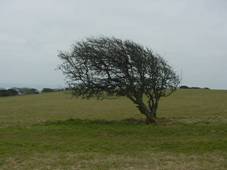
Tree in severe wind
What is wind chill and how does it work?
The wind cools humans and buildings by a process of convection. This affects the core temperature of human beings which is approximately 37 degrees Celsius. Quite simply the faster or stronger the wind the faster the cooling takes place. Wind chill can lead to hyperthermia, for example, in a sailing situation.

Wind chill factor on a summer's day
Can we experience wind chill on a summer's day on a beach where we have a natural sea breeze? In fact on a hot summer's day it is nice to experience the wind chill factor of the sea breeze. The difficulty is how we measure this feeling of temperature.
What the Met office say about wind chill
The Met Office has a temperature reading that indicates what the temperature will feel like. This interestingly is the strength of the wind around 1.5 metres (5 feet) which is the typical height from the ground of the human face.
This results in the ‘feels like' temperature that we mentioned before where the actual temperature is zero degrees but it feels like minus six degrees (the scientific way to measure this would be per square metre).

Modern day testing has looked at the question of how to measure the wind chill factor over and over again. In the UK the system generally used is JAG/TI which is the Joint Action Group for Temperature Indices and is how the Met Office gets to its ‘feel like' temperatures.
How does this affect me in buildings?
In our experience, whilst carrying out structural surveys and building surveys, the wind chill factor or accelerated wind does affect buildings in several ways. The first of which is drafts within the building. If you are sitting near a front door that opens directly to the outside or even a window then you may get a draft from this which in turn reduces your body temperature and makes you feel cold. Older style sliding sash windows are particularly known for this where they have not been maintained and therefore do not fit properly.

Old sash windows can be drafty
As mentioned a draft through a door or window and even in the building as a whole acts to form a wind chill factor that reduces the temperature of the room. We have taken measurements of surface temperatures, for example, on walls, windows and ceilings and found these to be pleasantly warm but the room still has a chill to it. This is often caused by a draft.
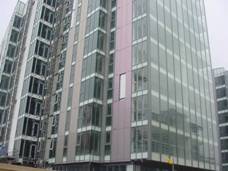
Highly Glazed flats or buildings can
suffer from wind chill
Here are some of our other surveying articles that may be of help to you:
Why have a Residential Building Survey?
Snow, ice and winter surveying problems in commercial property
Heavy, rain, gales and flood
Wind chill on the outside of a building
A phenomenon that we have come across a few times is wind chill factor on the outside of a building where accelerated wind cools down the outside of the building before drawing out heat from within the building. We found this to occur on buildings, for example, where there are car parks or garages underneath.
On houses this could be a second storey extension above a garage, on a flat this could be parking underneath it and equally it could be an office with parking underneath the property.
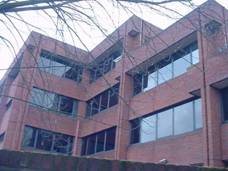
Offices suffered from wind chill
because of car park
underneath it

Car park under the office- the wind
gets underneath this
Wind chill or should we say convection of a building as a whole
The Wikipedia definition (we usually use these subject to some common sense checking) of convection is just too scientific to use. We found the free directory to be better in this instance and gave an example of air, heated by a space heater or radiator, replaced with cooler air creating a convection current that circulates around and throughout a room.
Convection definition (from free directory)
The process of heat transfer through a gas or liquid (for example, air) by a bulk motion of hotter material into a cooler region.
Interestingly whilst radiators radiate heat out the actual heat transfer around the room is via convection.

Air movement
Our Sketches
If our survey photographs do not explain the property problem enough then we will use our unique sketches that have been drawn especially for use in our building surveys to explain the issue further.

Property in an exposed location can
suffer from the elements
Independent Surveyors
If you truly do want an independent expert opinion from a Building Surveyor with regard to structural surveys, building surveys, structural reports, engineers reports, defects reports, dilapidations or any property problems please call us on 0800 298 5424 for a friendly chat.
Our Good, Bad & Ugly surveys!
We would like to introduce to you what we call our Good, Bad and Ugly survey which is a building survey, sometimes known as a structural survey, and is something that we have developed over many years, in fact several decades. We have listened to feedback from our clients and amended and altered our surveys to make them easy to read and describe issues clearly. The key factor we believe is that our surveys are easy to understand in plain English.
Compare the quality of our website articles and our surveys
Have a look around our website 1stAssociated.co.uk to see the quality of our articles, such as the one you are reading, and look at the quality of our surveys (we are more than happy to send you an example). We pride ourselves on our professional standard and easy to read reports which we have been carrying out for many years on every age, type and style of property across the UK .
The content of the website is for general information only and is not intended to be relied upon for specific or general decisions. Appropriate independent professional advice should be paid for before making such a decision Free phone 1stAssociated.co.uk on 0800 298 5424.
All rights reserved by 1stAssociated.co.uk
All rights are reserved the contents of the website are not to be reproduced or transmitted in any form in whole or part without the express written permission of www.1stAssociated.co.uk
